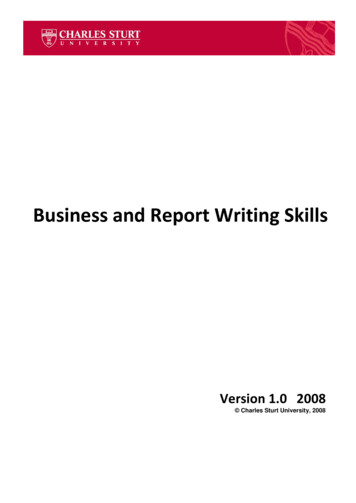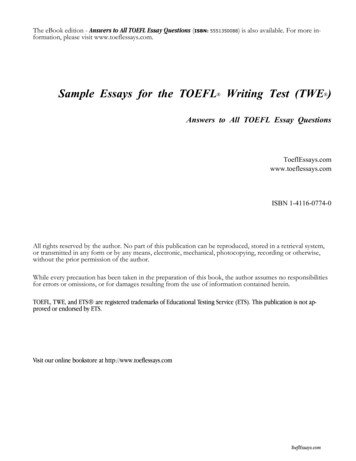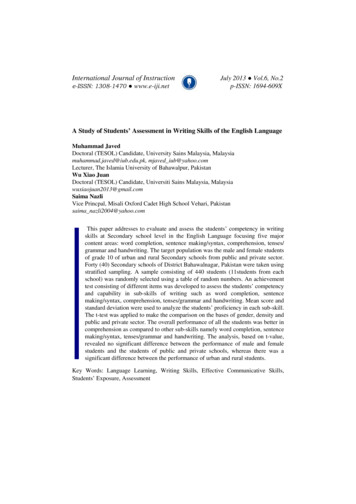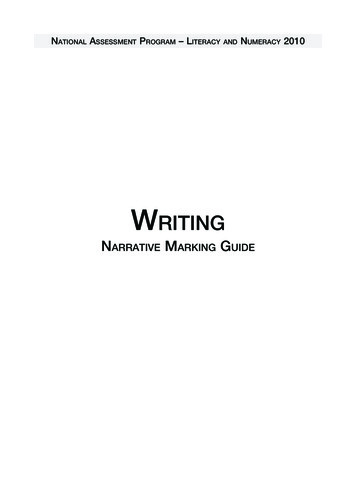
Transcription
Writing Skills TestThe ASSET Writing Skills Test is a 36-item, 25-minute test that measures the student's understanding ofthe conventions of standard written English in punctuation, grammar, sentence structure, strategy,organization, and style. Spelling, vocabulary, and rote recall of rules of grammar are not tested.The test consists of three prose passages, each accompanied by a sequence of 12 multiple-choice testitems. To provide a variety of rhetorical situations, a range of passage types is employed. Items thatmeasure usage and mechanics offer alternative responses, including "NO CHANGE," to underlinedportions of the text. The student must decide which alternative employs the conventional practice inusage and mechanics that conforms to the sense of the context. Items that measure rhetorical skills mayrefer to an underlined portion of the text or may ask about a section of the passage or the passage as awhole. The student must decide which alternative response is most appropriate in a given rhetoricalsituation.The elements of the Writing Skills Test and the approximate proportions of the test devoted to each aregiven below. Punctuation. Tests such conventions as the use and placement of commas, colons, semicolons,dashes, parentheses, apostrophes, question marks, and exclamation points. Grammar. Tests adjectives and adverbs, conjunctions, and agreement between subject and verband between pronouns and their antecedents. Sentence Structure. Tests relationships between/among clauses, placement of modifiers, andshifts in construction. Organization. Tests the organization of ideas and the relevance of statements in context (order,coherence, unity). Strategy. Tests the appropriateness of expression in relation to audience and purpose, thestrengthening of writing with appropriate supporting material, and the effective choice ofstatements of theme and purpose. Style. Tests precision and appropriateness in the choice of words and images, rhetoricallyeffective management of sentence elements, avoidance of ambiguous pronoun references,and economy in writing.
Writing Skills Test Item ClassificationClassificationProportion of Test Number of nce Structure .3613Rhetorical tyle.06–.112–4Total1.0036Writing Skills1. Determine the intended meaning of eachparagraph before trying to answer items inthat paragraph.2. Substitute each alternative into theappropriate underlined portion for each itemand select the one that fits best with themeaning of the paragraph.Sample Writing Skills TestDirections: In the passage that follows, certain words and phrases are underlined and numbered. In theright-hand column, you will find alternatives for each underlined part. You are to choose the one thatbest expresses the idea, makes the statement appropriate for standard written English, or is wordedmost consistently with the style and tone of the passage as a whole. If you think the original version isbest, choose “NO CHANGE.” You will also find questions about a section of the passage or about thepassage as a whole. For each question in the test, choose the alternative you consider best and fill in thecorresponding space on your answer sheet. Read each passage through once before you begin toanswer the questions that accompany it. You cannot determine some answers without reading severalsentences beyond the phrase in question. Be sure that you have read far enough ahead each time youchoose an alternative.
Writing Skills Answer Key1. B 6. C 11. A2. C 7. A 12. C3. B 8. A4. D 9. D5. B 10. A
Reading Skills TestThe ASSET Reading Skills Test is a 24-item, 25-minute test that measures reading comprehension as aproduct of skill in referring and reasoning. The test items require students to derive meaning from severaltests by (1) referring to what is explicitly stated and determining the meaning of words through contextand by (2) reasoning to determine implicit meanings and to draw conclusions, comparisons, andgeneralizations.The test consists of three prose passages of about 375 words each that are representative of the leveland kinds of writing commonly encountered in college freshman curricula. Passages on topics in prosefiction, business, and the social studies are included. Each passage is accompanied by a set of eightmultiple-choice test items.The approximate proportion of the test devoted to each type of reading item is given below.Reading Skills Test Item ClassificationClassification Proportion of Test Number of ItemsReferring.5012Reasoning.5012Total1.0024
Reading Skills Answer Key1. C 4. C 7. B2. D 5. A 8. A3. C 6. B
Advanced Mathematics Test: IntermediateAlgebraThe Intermediate Algebra Test is designed to assess skills commonly acquired in a second high schoolalgebra course. The content areas tested include: solutions of polynomial equations by factoringgraphs of linear equationsoperations with radical and rational expressionsthe distance formulaslope of a linesolution of linear inequalitiessimplification of radicalsStudents may use calculators on the ASSET advanced-level mathematics tests.Intermediate Algebra Test Item ClassificationClassificationElementary AlgebraProportion of Test Number of Items.205Intermediate Algebra and Coordinate Geometry .6416College Algebra.164Total1.0025
Intermediate Algebra Answer Key1. E2. D3. BAdvanced Mathematics Test: College AlgebraThe College Algebra Test is designed to assess skills commonly acquired in a precalculus course. Thecontent areas tested include: exponential functionsfactorialsoperations with complex numberscomposition of functionsinverses of functionslinear inequalitiesgraphs of polynomialsStudents may use calculators on the ASSET advanced-level mathematics tests.College Algebra Test Item ClassificationClassificationProportion of Test Number of ItemsIntermediate Algebra .123College Algebra.6416Trigonometry.246Total1.0025
College Algebra Answer Key1. C2. B3. B
Writing Skills Test The ASSET Writing Skills Test is a 36-item, 25-minute test that measures the student's understanding of the conventions of standard written English in punctuation, grammar, sentence structure, strategy, organization, and style. Spelling, vocabu










